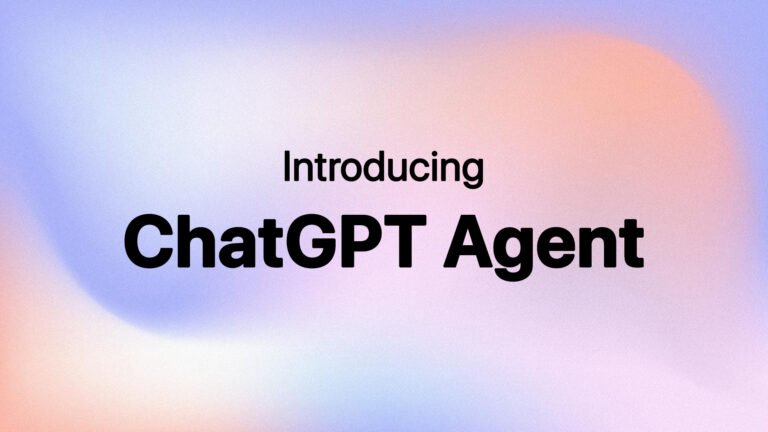OpenAI has officially launched one of its most ambitious tools yet—ChatGPT Agent—a powerful evolution of AI that can plan, research, browse, generate documents, and even take real-time actions on your behalf. It’s more than just a chatbot—it’s a fully interactive, multi-tool assistant that can collaborate, adapt, and think through complex workflows like a human teammate.
Let’s explore how ChatGPT Agent changes the way we interact with AI, what makes it so powerful, and why this might be one of the biggest moments in AI development so far.
What Is ChatGPT Agent?
ChatGPT Agent is a virtual AI assistant embedded within ChatGPT, available for Pro, Plus, and Team users (Enterprise and Education versions are coming soon). It operates inside a virtual computer equipped with a suite of tools:
- A text browser (like Deep Research) for reading and parsing large volumes of information from web pages.
- A visual browser (like Operator) for interacting with UI elements like buttons, dropdowns, and forms.
- A terminal to write and execute code, connect to APIs, generate or edit documents, and handle files like spreadsheets or presentations.
- Image generation capabilities for creating graphics or visuals, particularly useful for slides or branding assets.
It combines these tools intelligently, trained using reinforcement learning, and learns how to select the best tool depending on the task.
Also Read: ChatGPT Prompts for Instagram
From Idea to Action: How It Works
The team demoed ChatGPT Agent by giving it a real-world challenge: plan for a wedding. The AI was asked to:
- Suggest suitable outfits matching a dress code.
- Consider weather and venue.
- Recommend hotels.
- Choose a wedding gift.
By simply enabling “Agent Mode” inside ChatGPT, the AI took over:
- It accessed the browser to research the wedding date and location.
- Switched to the visual browser to check and compare outfits.
- Opened hotel sites and gathered availability, prices, and screenshots.
- Asked clarifying questions like “What’s the wedding date?” and responded smoothly to mid-task interruptions like adding a search for men’s shoes in size 9.5.
This level of contextual memory, interaction, and multitasking is what makes ChatGPT Agent groundbreaking.
Real-Time Tool Switching: How It Thinks
What’s remarkable is how ChatGPT Agent chooses when and how to use different tools:
- It starts with the text browser for efficient reading and searching.
- Shifts to the GUI browser when visual interaction is needed (e.g., choosing clothing).
- Opens the terminal to execute code or connect to external services like Google Drive, GitHub, or SharePoint.
- Generates visuals using image-gen API for creative tasks like designing swag or slides.
Its decisions are guided by reinforcement learning. During training, the model faced hard, multi-step tasks—forcing it to learn tool selection and sequencing. Over time, it stopped overusing tools and became more strategic and efficient.
Multi-Turn Collaboration with Users
Unlike static chatbots, ChatGPT Agent acts more like a human assistant. It:
- Pauses to ask clarifying questions.
- Allows mid-task interruptions—users can give new instructions anytime.
- Requests confirmations before important actions (like sending an email or placing an order).
- Accepts user corrections or manual input via “takeover mode”.
For example, during the demo, when the team asked for laptop stickers, the agent worked independently:
- Created anime art for the mascot using image generation tools.
- Added items to the cart.
- Asked the user for payment confirmation—offering full transparency before completing the purchase.
Benchmarks and Evaluation
To test its capabilities, ChatGPT Agent was evaluated on several benchmarks:
- WebArena: Measured its ability to perform real-world tasks on the web. It significantly outperformed the earlier GPT-4-turbo model (O3).
- SpreadsheetBench: With access to LibreOffice and Excel via the terminal, it completed 45% of real-world spreadsheet tasks.
- Banking Benchmarks: Outperformed previous models on tasks like building three-statement financial models.
- Frontier TMS and Humanities Last Exam: Demonstrated high reasoning ability—doubling performance when tools were available.
- BrowseComp: Achieved 69% pass rate in browsing-related tasks.
These results highlight the agent’s ability to not just chat, but think, research, and execute like a skilled professional.
Security: Powerful but Cautious
While ChatGPT Agent is impressive, OpenAI emphasized the new risks involved:
- Prompt injections: Malicious sites might trick the agent into performing unsafe actions like submitting sensitive data.
- Real-time monitoring: OpenAI has implemented layered monitoring systems that can stop the agent mid-task if something seems suspicious.
- Users are advised to manually input sensitive data (e.g., credit card info) and be cautious with what access is granted to the agent.
Like the early days of the internet, people must learn how to safely interact with AI agents and understand that power comes with responsibility.
Final Thoughts: A Leap Toward the Future
ChatGPT Agent isn’t just an upgrade—it’s a revolution in task automation. It empowers users to offload complex workflows that typically take hours—like planning events, creating presentations, doing research, or writing code—and lets the AI do it instead.
Available now for Pro and Team users with plans to expand further, this launch is only the beginning. Expect rapid improvements, broader integrations, and more user control.
As OpenAI’s team said, “It’s like having an AI teammate that never sleeps.” With the ChatGPT Agent, we’re not just chatting—we’re getting things done.
Subscribe for Newsletter

